By Evelyn Nguyen, Mar 17, 2025
Vietnam has an amazing variety of food that differs by region and occasion. In particular, the traditional food eaten during Vietnamese New Year is especially important and delicious for tourists who visit Vietnam in New Year Holiday. In this blog, Incredible Asia Journeys will tell you about TOP must-try traditional Vietnamese New Year Food.
Follow us as we explore the diverse range of Vietnamese cuisine from the North to the South during the Lunar New Year!
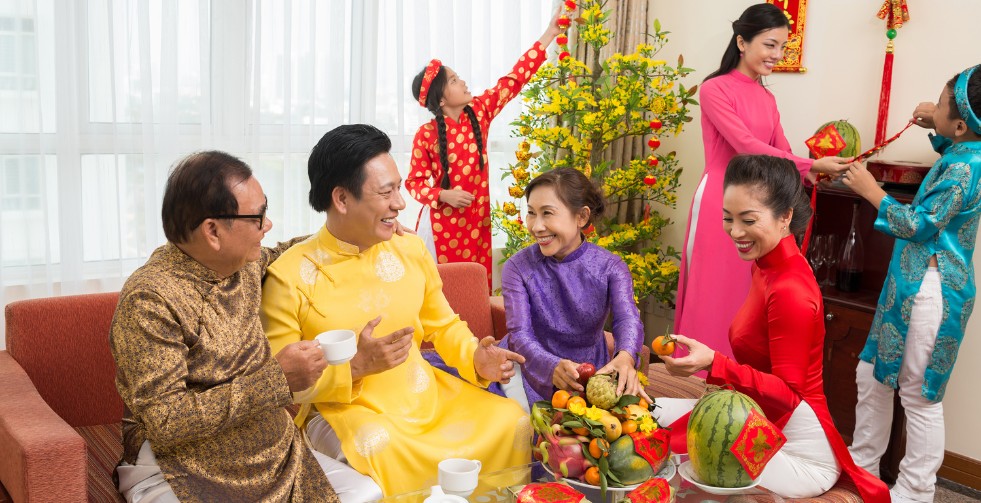
Traditional Tet (Lunar New Year) in Vietnam
Tet (Lunar New Year) is the greatest and most important occasion in Vietnam, marking the arrival of spring based on the lunar calendar. Celebrated in late January or early February, Tet signifies a fresh start and new beginnings, it’s a time for Vietnamese family reunions, paying respects to ancestors, and enjoying special festive foods. Therefore, even though family circumstances are difficult, people still try to prepare a full Tet feast. So, tourists coming to Vietnam to savor the traditional food is the best thing to do in Vietnam!
The differences in weather across Vietnam during the Lunar New Year lead to diverse Vietnamese New Year food that reflects the local climate and agricultural practices. In the north, the weather is cold and dry influencing the preference for hearty and warming dishes during the chilly days.
Meanwhile, in central Vietnam, the weather can be milder but still wet, leading to foods that balance flavors and preserve ingredients. Central Vietnam Tet food is often packed with intense flavors to complement the humid climate.
In the south, the weather is typically warm and dry, encouraging the use of fresh, tropical ingredients in dishes. The abundance of fresh produce and milder climate result in lighter, sweeter dishes that are perfect for the festive season.
Thus, the distinct weather patterns, lifestyles, and available resources in each region shape the unique Tet food traditions across Vietnam.

Each region in Vietnam has its unique Tet lifestyles
Typically, Vietnamese Lunar New Year food varies by region, with each having its unique Vietnamese Tet food. Get ready foodies, it’s time to sneak a peak at each region's dining table!
Banh Chung stands at the top of the list of Vietnamese food during Lunar New Year. This square-shaped rice cake is made from mung beans, seasoned pork, and sticky rice, all wrapped in dong leaves.
Traditionally, the square shape of Banh Chung Vietnamese New Year food represents the Earth and holds deep meanings related to the universe. When eaten, you can feel the chewy sticky rice, the pork is savory and tender, and the mung bean paste is smooth and subtly sweet.
Northern people also enjoy a fried version of Banh Chung, where slices of the cake are pan-fried with a little oil over moderate heat until the outer layer becomes crispy while the inside remains soft.
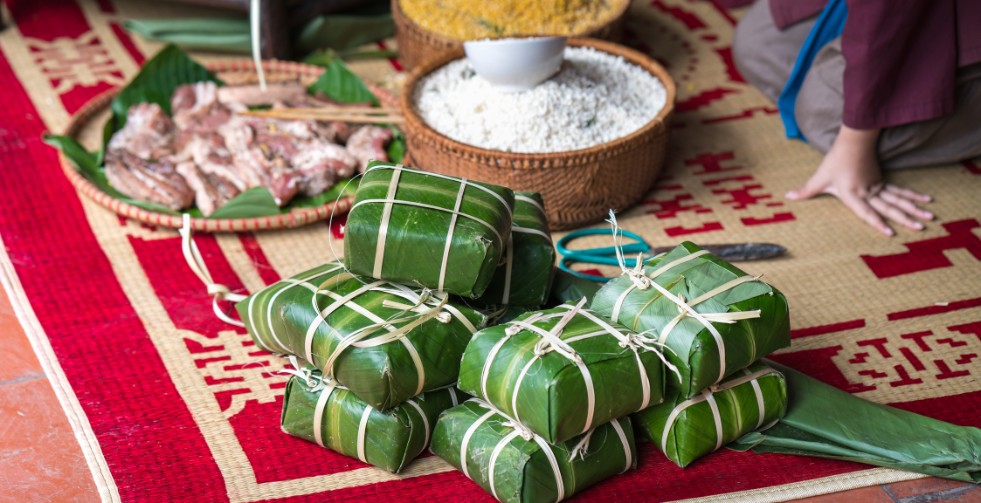
Banh Chung is preparing to be boiled
Xoi Gac is known for its vibrant red color which symbolizes good luck and prosperity. This festive sticky rice dish is made from glutinous rice mixed with the flesh of Gac fruit (Cochinchin gourd), which imparts its striking hue. The process begins with soaking the rice and then combining it with the gac fruit, coconut milk, and a bit of sugar to enhance the sweetness.
When you take a bite of Xoi Gac, you'll experience chewy and slightly sweet sticky rice, while the coconut milk adds a creamy richness. The subtle sweetness of the rice is perfectly balanced by the aromatic essence of the gac fruit, making each mouthful a unique and enjoyable experience. This dish is often enjoyed as a part of the Vietnamese New Year dishes and is also served during other festive occasions to bring good fortune throughout the year.
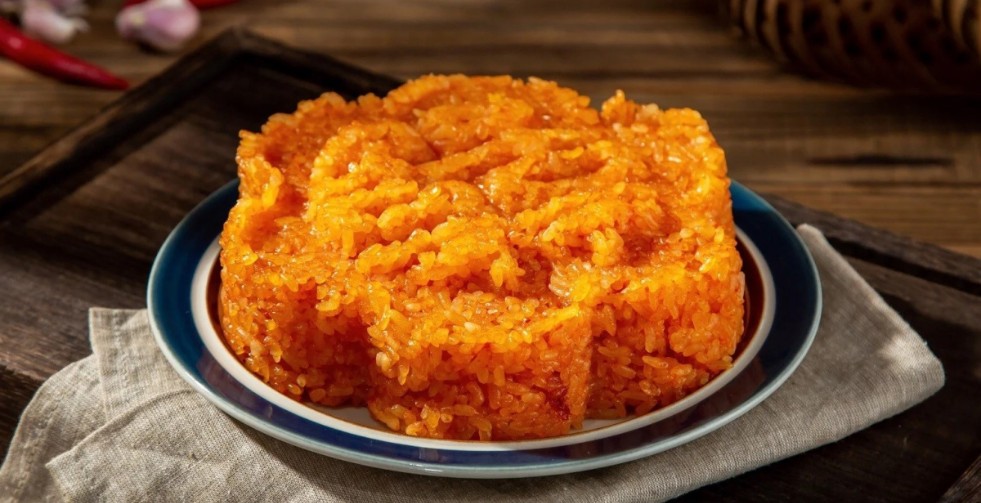
The beautiful color of Xoi Gac
Gio is another Vietnamese New Year food, often served alongside Xoi (sticky rice) and Banh Chung. This traditional sausage is crafted from lean meat mixed with fish sauce, wrapped in leaves, and boiled for several hours. Eating Gio Lua, you can feel a delicately flavored sausage with a smooth, firm texture that complements the other festive dishes perfectly.
There are various types of Gio, classified by their main ingredient: Gio Lua (pork), Gio Ga (chicken), and Gio Bo (beef). These varieties are not only enjoyed during Tet but are also popular year-round in Vietnamese cuisine.
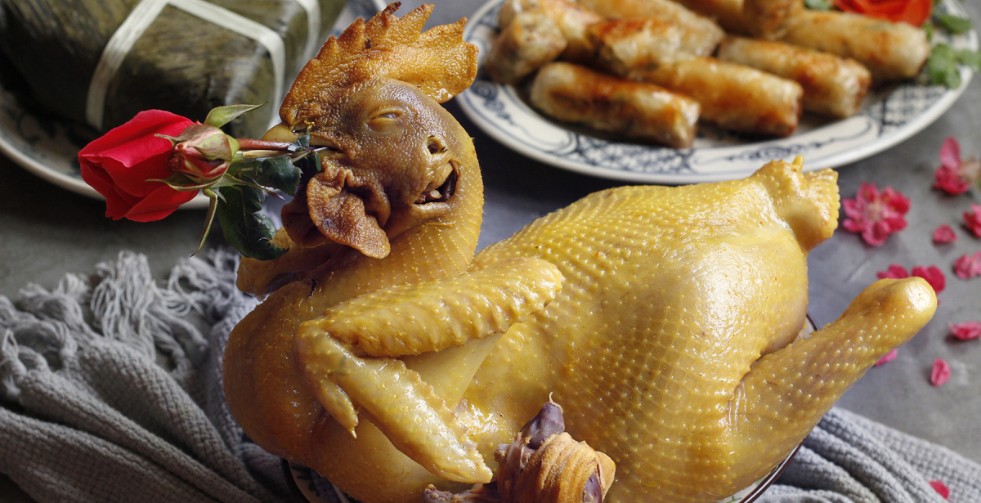
Ga Luoc (Boiled chicken)
Ga Luoc, or boiled chicken, is often used in offerings to ancestors and is a symbol of prosperity and unity. The preparation sounds simple yet precise, a whole chicken is boiled until the meat is tender and the skin is a beautiful golden hue without crack.
The resulting flavor is subtly savory, with the chicken's natural juices enhanced by a touch of salt. It is typically served with a side of salt, pepper, and lime dipping sauce, which adds a zesty kick to each bite.
Nem Ran, also known as fried spring rolls, is one of the most popular traditional foods not only served in Northern Vietnam but also in other regions in Tet. These crispy rolls are filled with a mixture of minced pork, mushrooms, vermicelli noodles, and various vegetables, all seasoned to perfection. The rolls are wrapped in rice paper and then fried until golden brown and crispy.
When you bite into a Nem Ran, you experience a satisfying crunch followed by a burst of savory and aromatic flavors from the filling. They are typically served with a bowl of dipping sauce made from fish sauce, lime juice, sugar, and chili, which complements the rich and savory rolls perfectly.
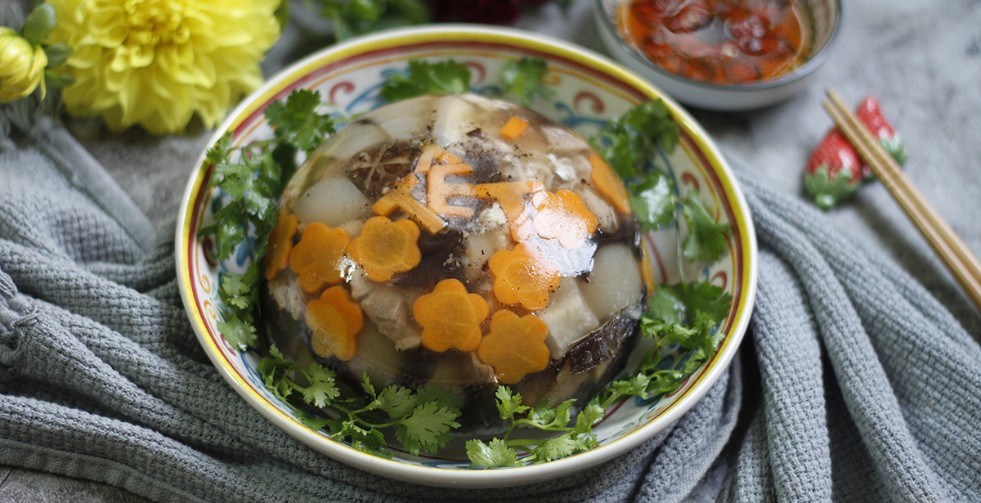
Thit Dong (Jellied Pork)
Thit Dong is food for Vietnamese new year in northern Vietnam. This cold dish is made by simmering pork and pork skin with fish sauce, pepper, and garlic until the natural gelatin from the pork creates a jelly-like consistency. Once cooled, the mixture solidifies into a savory jelly that is sliced and served.
The flavor of Thit Dong is savory and slightly garlicky, with a smooth and silky texture that melts in your mouth. It's often enjoyed with pickled vegetables and sticky rice, providing a refreshing contrast to the rich and savory jelly.
Banh Tet is a traditional Vietnamese New Year food enjoyed especially in central and southern Vietnam. Similar to Banh Chung, Banh Tet is made from glutinous rice, mung beans, and pork, but it is shaped into a cylindrical roll and wrapped in banana leaves before being boiled.
The cooking process, which takes several hours, results in a flavorful and hearty cake that is sliced into rounds for serving. The banana leaves impart a unique aroma that enhances the overall taste, making Banh Tet a cherished dish during the Lunar New Year.
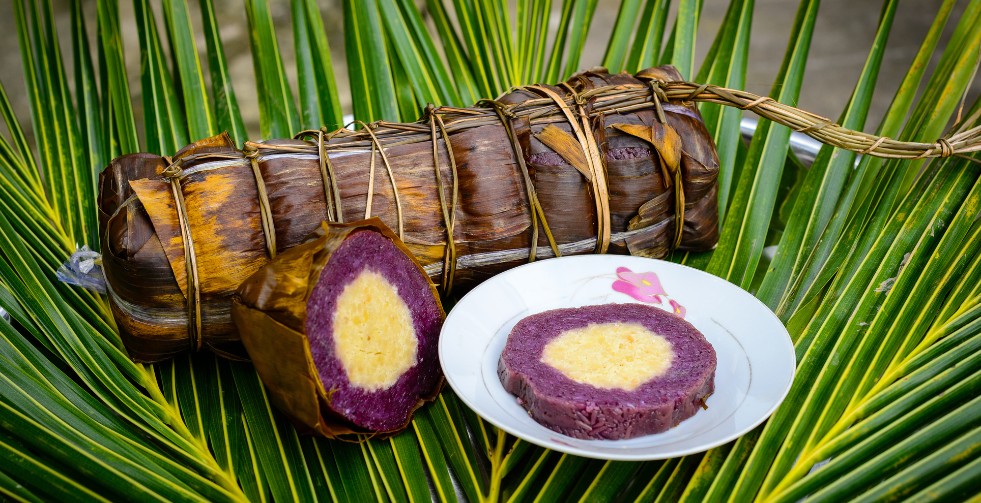
Black Cylindrical Sticky Rice Cake - Banh Tet
Banh In, or print cake, is a sweet treat commonly enjoyed during Tet in central Vietnam. These small, decorative cakes are made from rice flour and sugar and are often imprinted with intricate designs. They come in various flavors, including mung bean and coconut.
Banh In has a dense and slightly chewy texture, with a delicate sweetness that pairs well with tea. The detailed prints on each cake not only make them visually appealing but also represent good luck and prosperity for the new year. Tourists can buy this cake as a souvenir to bring home in Vietnam in New Year Holiday tour.
Nem Chua is a popular food in Central Vietnam, particularly as a specialty in Thanh Hoa. Made from minced pork, pork skin, garlic, and chili, Nem Chua is seasoned and then wrapped in banana leaves to ferment for several days. The fermentation process gives the pork a unique sour taste and a chewy texture.
Each bite of Nem Chua is a burst of tangy, savory, and slightly spicy flavors, making it a delicious and refreshing snack. It is often enjoyed with fresh herbs and chili sauce, adding to the complexity of flavors.
Tom Chua is a specialty of central Vietnam originating from Hue. This dish is made by fermenting fresh shrimp with a mixture of rice, galangal, garlic, and chili. The fermentation process results in a tangy and slightly spicy flavor, with the shrimp retaining a firm and juicy texture.
Tom Chua is typically served with fresh herbs and rice paper, allowing diners to create their own flavorful rolls. The combination of sour, spicy, and savory flavors makes Tom Chua a standout dish during the Lunar New Year festivities.
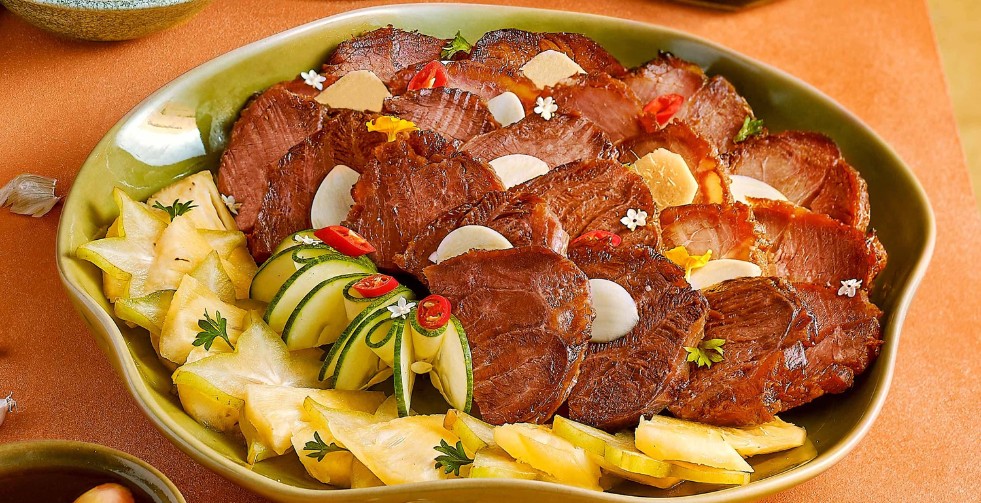
Bo Kho Mat Mia (Braised Beef With Molasses)
Bo Kho Mat Mia is a rich and flavorful dish from Nghe An, central Vietnam. This dish features beef braised with molasses, fish sauce, and various aromatic spices until the meat is tender and infused with a deep, sweet-savory flavor. The molasses add a caramelized sweetness that balances the robust taste of the beef, while the spices contribute to a complex and aromatic profile.
The slow-cooking process ensures that the flavors meld beautifully, resulting in a dish that is both hearty and indulgent. Bo Kho Mat Mia is often served with rice or noodles, making it a comforting and satisfying meal during the festive season.
Thit Kho Hot Vit is a beloved dish during Tet in southern Vietnam, featuring succulent pieces of pork belly braised with duck eggs in a rich, caramelized sauce made from coconut water, fish sauce, and sugar. The slow-cooking process allows the pork to become incredibly tender, while the duck eggs absorb the savory-sweet flavors of the sauce.
It is supposed that the round eggs and square pieces of meat are symbols of balanced yin and yang. Thit Kho Hot Vit is typically served with rice, making it a comforting and satisfying meal that symbolizes prosperity and warmth in Tet. Don’t miss the chance to try this food during your Best of Vietnam for New Year!
Canh Kho Qua, or stuffed bitter melon soup, is a traditional dish in southern Vietnam that is often enjoyed during Tet. The dish features bitter melon stuffed with a mixture of minced pork, mushrooms, and glass noodles, all seasoned with fish sauce and pepper.
The bitterness of the melon is believed to symbolize the hardships of the past year, which are washed away with each bite. The soup is both refreshing and nourishing, with a unique combination of bitter and savory flavors that are said to bring good health and fortune.
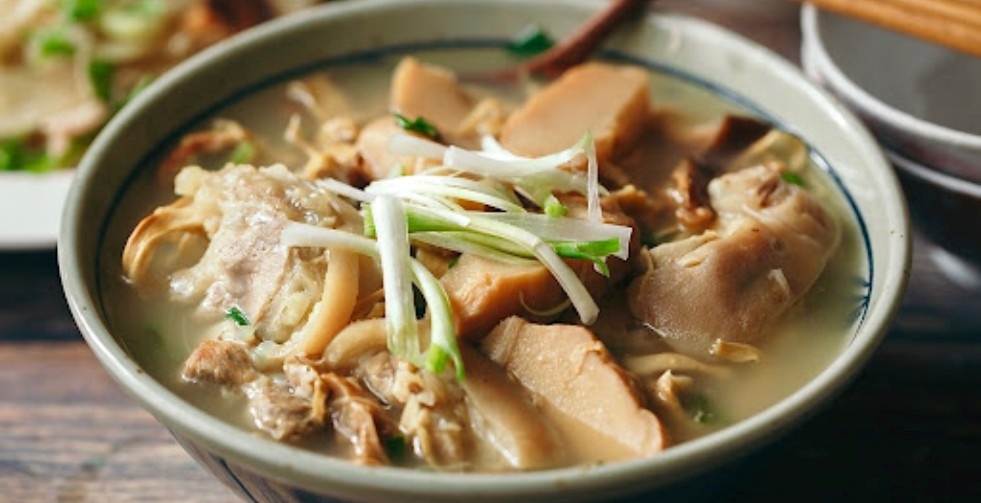
Canh Mang (Bamboo Shoot Soup)
Canh Mang is made from dried bamboo shoots, pork ribs, and various aromatic herbs. The dried bamboo shoots are rehydrated and simmered with the pork ribs to create a rich and savory broth. The bamboo shoots add a distinct earthy flavor and a slightly crunchy texture to the soup.
Canh Mang is often enjoyed as part of the Tet feast, symbolizing growth and resilience. Its hearty and warming qualities make it a perfect dish to share with family and friends during the festive season.
Lap Xuong, or Chinese sausage, is a popular ingredient in southern Vietnamese cuisine, especially during Tet. These sweet and savory sausages are made from ground pork and fat, seasoned with sugar, soy sauce, and rice wine, then air-dried or smoked.
This flavorful and slightly chewy sausage is often sliced and stir-fried with vegetables or used as a topping for sticky rice. The sweet and smoky flavor of Lap Xuong adds a delightful contrast to the savory dishes typically served during Tet.
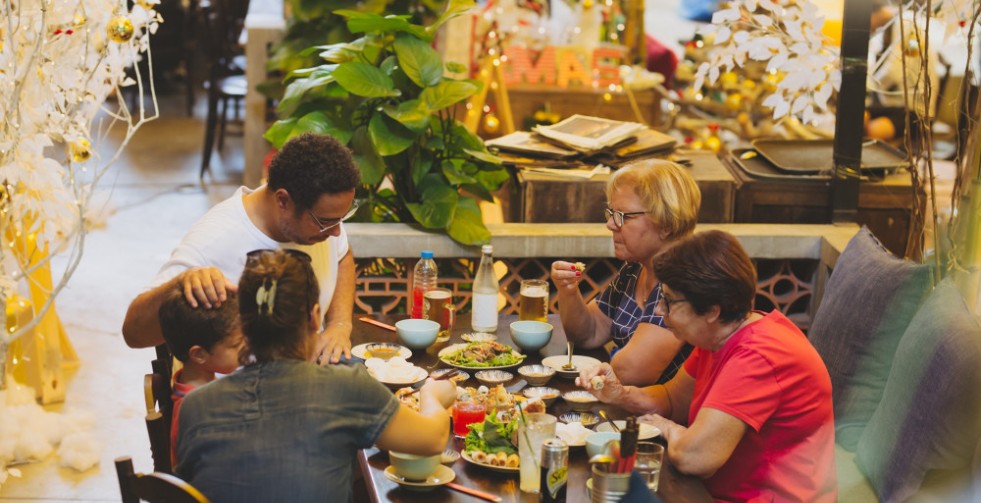
Try to savor a Tet meal in Vietnam
Tet is a time of deep tradition and cultural significance in Vietnam, and the meals shared during this period are much more formal and elaborate than everyday meals. Here are some essential table manners to keep in mind if you dine with locals or wish to experience an authentic Tet meal:
- Do not start eating until the incense on the ancestor’s altar has finished burning.
- Always invite the elders to eat first as a sign of respect.
- Do not clatter your chopsticks or bowl, as it is considered rude.
- Finish all the rice you have taken, it is considered wasteful and disrespectful to leave rice in your bowl.
- Wait for the host to indicate where you should sit if you are a guest. The seating arrangement may be based on age or status.
New Year in Vietnam is an incredible opportunity to explore the unique and mouthwatering cuisine that is exclusive to this festive holiday. You don't want to miss out on the chance to savor all these amazing dishes and immerse yourself in the rich tapestry of traditional Vietnamese food during the New Year celebration.
If you're planning a trip to Vietnam during the New Year holiday and need help with booking tours, look no further! Incredible Asia Journeys is here to make your adventure unforgettable.